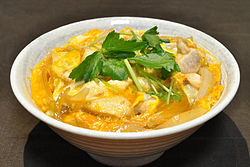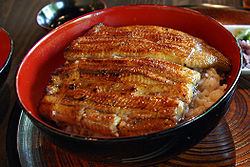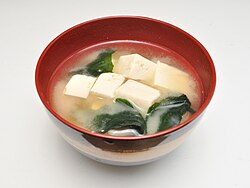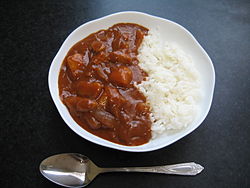This article needs additional citations for verification .(December 2012) |
 |
| This article is part of the series |
| Japanese cuisine 日本料理 |
|---|



Below is a list of dishes found in Japanese cuisine. Apart from rice, staples in Japanese cuisine include noodles, such as soba and udon. Japan has many simmered dishes such as fish products in broth called oden, or beef in sukiyaki and nikujaga. Foreign food, in particular Chinese food in the form of noodles in soup called ramen and fried dumplings, gyoza, and other food such as curry and hamburger steaks are commonly found in Japan. Historically, the Japanese shunned meat, but with the modernization of Japan in the 1860s, meat-based dishes such as tonkatsu became more common.
Contents
- Rice dishes (ご飯物)
- Rice porridge (お粥)
- Rice bowls (どんぶり)
- Sushi (寿司)
- Other staples
- Noodles (men-rui, 麺類)
- Bread (pan, パン)
- Common Japanese main and side dishes (okazu, おかず)
- Deep-fried dishes (agemono, 揚げ物)
- Grilled and pan-fried dishes (yakimono, 焼き物)
- Nabemono (one pot cooking, 鍋物)
- Nimono (stewed dishes, 煮物)
- Itamemono (stir-fried dishes, 炒め物)
- Sashimi (刺身)
- Soups (suimono (吸い物) and shirumono (汁物))
- Pickled or salted foods (tsukemono, 漬け物)
- Side dishes (惣菜)
- Chinmi (珍味)
- Sweets and snacks (okashi (おかし), oyatsu (おやつ))
- Japanese-style sweets (wagashi, 和菓子)
- Old-fashioned Japanese-style sweets (dagashi, 駄菓子)
- Western-style sweets (yōgashi, 洋菓子)
- Sweets bread (kashi pan, 菓子パン)
- Other snacks
- Tea and other drinks
- Tea and non-alcoholic beverages
- Alcoholic beverages
- Imported and adapted foods
- Foods imported from Portugal in the 16th century
- Yōshoku
- Other homegrown cuisine of foreign origin
- Adaptations
- Seasonings
- See also
- References





















![Yakizakana [ja] (grilled Fish) Yakizakana.jpg](http://upload.wikimedia.org/wikipedia/commons/thumb/1/13/Yakizakana.jpg/250px-Yakizakana.jpg)









![Karashimentaiko [ja] (Xin Zi Ming Tai Zi
) Mentaiko by Kanko.jpg](http://upload.wikimedia.org/wikipedia/commons/thumb/1/1b/Mentaiko_by_Kanko.jpg/250px-Mentaiko_by_Kanko.jpg)


![Ohitashi [ja] (oJin shi
) Spinach Ohitashi.jpg](http://upload.wikimedia.org/wikipedia/commons/thumb/7/77/Spinach_Ohitashi.jpg/250px-Spinach_Ohitashi.jpg)

















![Tarako spaghetti [ja] (tarakosupagetsutei
) Tarako spaghetti.jpg](http://upload.wikimedia.org/wikipedia/commons/thumb/e/ee/Tarako_spaghetti.jpg/250px-Tarako_spaghetti.jpg)
